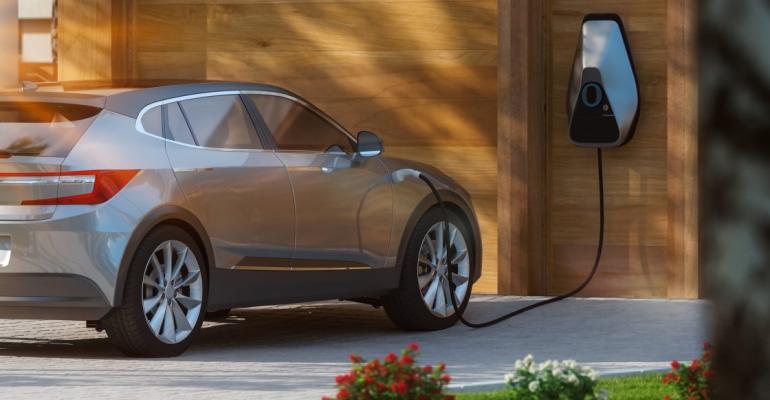Battery-electric vehicles are making headlines almost every day. With all the media attention, it’s easy to forget that only 4% of Americans own a BEV.
That’s about to change. More than a third (36%) of consumers looking for a new car have BEVs at the top of their list. That number is going to grow as infrastructure is improved and more electrified CUVs and SUVs hit the market. And with greater adoption of BEVs comes a need for greater guidance and education about charging at home and on the road.
Current charging habits contain key learnings BEV makers need to know. By understanding how consumers charge their cars after driving off the dealership lot, auto manufacturers can point consumers in the direction of sound information to help them feel secure and confident in their BEV purchase – all while helping utilities prepare for the influx of BEVs and the increased demand they place on the grid.
Consumers Charging Their EVs at Home Should Be Grid-Conscious
According to the National Bureau of Economic Research, regular charging of an electric vehicle increases a household’s average electricity consumption by 2.9 kWh per day. This research found that electricity consumption rose within a couple of weeks of an owner registering a BEV and remained constant for the next six months.
Without proper education on charging their vehicles, BEV owners could develop unhealthy habits that are not beneficial to the grid, the planet or their wallets. By learning proper vehicle charging from their auto manufacturers or their utility, BEV owners can keep their cars charged and their bills low.
As part of this education, recent buyers should also be encouraged to contact their utility providers to see if they offer programs or incentives for owning a BEV. Many utilities offer managed charging programs, rebates on Level 2 chargers and other incentives for BEV owners to maximize their purchases while remaining efficient. Every consumer who fails to check in with their utility is a missed opportunity to optimize charging habits. This missed opportunity becomes amplified as more BEVs enter garages across the country.
The Demand for Faster Charging Is High
Without the right guidance and instruction, BEV owners can see their bills skyrocket. Level 2 charging is higher voltage, allowing BEV owners to charge their cars fully overnight. Level 2 charging happens at 240V of alternating current, the standard for large residential appliances such as stoves, water heaters and clothes dryers. Level 2 chargers can typically take a battery from zero to a full charge in less than six hours, making them of considerable interest to EV owners. Trying to charge an EV from a 110V outlet could take more than 24 hours depending on level of charge when it is plugged in.
We know that customers are buying Level 2 chargers for their homes. A J.D. Power study found that 68% of BEV owners had a Level 2 charger at home, but despite this, BEV owners were dissatisfied with their at-home charging because of electricity costs. So, how can BEV owners become more satisfied with their charging at home?
By talking to their utility provider, BEV owners can figure out the best way to charge their cars quickly and reliably in the comfort of their garage. Often, BEV owners are unaware of programs, such as BEV-specific rates or off-peak charging rates, that can enable them to take advantage of faster charging while bringing down the overall cost of charging at home. These programs, combined with communications from their utility, will create more satisfied BEV owners who will likely purchase another BEV when the time comes.
Charging Overnight Is Easy, Cost Effective and Good for the Grid
To effectively communicate charging best practices, automakers and utilities will get the best response from customers by keeping their messaging simple and consistent. While utilities across the country are laying out a myriad of program designs, differing time-of-use rates and other novel programs, they risk confusing customers with too many options and instructions. The simpler the message, the more likely customers can create lasting behaviors that are beneficial to balancing the load on the grid.
One of the simplest programs offered by utilities is offering lower, BEV-specific energy rates at night to promote overnight charging. This shifts charging away from peak times during the day when the grid is working hard to support the majority of at-home energy and commercial consumption. This messaging and behavior matches customers’ needs today; according to the U.S. Department of Energy, 80% of BEVs are charged at home and almost exclusively at night.
 As the number of BEVs on the road grows, knowing where customers are located and where they charge their cars most often will help automakers better understand consumers’ charging habits, educate them on the best charging practices and help balance increased energy demand.
As the number of BEVs on the road grows, knowing where customers are located and where they charge their cars most often will help automakers better understand consumers’ charging habits, educate them on the best charging practices and help balance increased energy demand.
As utilities and auto manufacturers work together, mass BEV adoption can more seamlessly happen at home, allowing more people to swap the gas station for their garage – in service of their wallets and the planet.
Erin D’Amato (pictured, above left) is director of innovative solutions at Uplight, a provider of software solutions connecting energy customers to the decarbonization goals of power providers.





